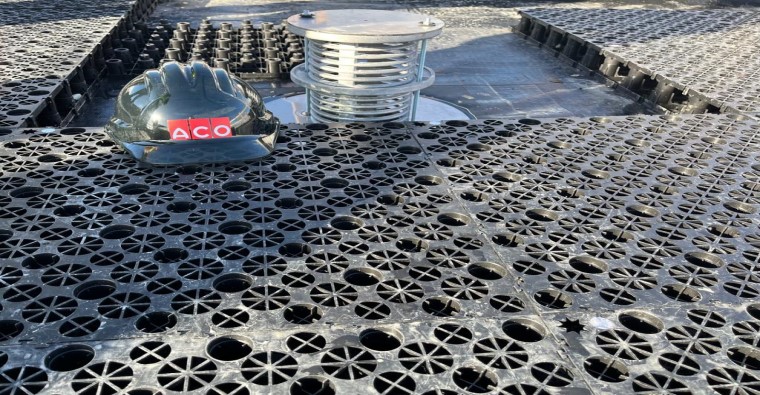
Making Sustainable Water Solutions a Reality with Blue Roofs
In the UK, water scarcity is a pertinent problem that requires innovative water management solutions. Blue roofs present a feasible answer to this issue while also promoting a sustainable water cycle aligning with the United Nations’ Sustainable Development Goals. Here, Neill Robinson-Welsh, consultant at ACO Building Drainage, explains the benefits of blue roofs and how the systems could help ease water scarcity.
As an ambassador for the sixth UN Sustainable Development Goal (UN SDG), ‘Clean Water and Sanitation’, ACO takes its global commitment to sustainable water practices seriously, and blue roofs are a key component in achieving ongoing sustainability. The UN SDG 6 is a vital target which prioritises the protection of water, ensuring it continues to be a renewable resource. Water storage and treatment on site is a crucial technique for improving water sustainability and, by applying techniques and industry expertise, can significantly contribute to the macro-objectives of a development project.
Blue Roofs: What Are They?
The main difference between traditional flat roofs and blue roofs is that the former is designed to quickly drain water whereas blue roofs are a separate system which temporarily holds rainwater and slowly releases it. This helps control stormwater runoff, especially in dense urban areas, limiting the load on sewer systems and mitigating the risk of flooding. As the effects of climate change increase levels of stormwater, and urban areas continue to expand, safeguarding water resources is an ever-important concern.
Why are Blue Roofs Needed?
By the mid-2030s, water demand in the UK is forecast to exceed supply unless meaningful infrastructure improvements are made.[1] The privatisation of water services in 1989 led to underinvestment which rendered the UK’s water infrastructure unable to meet rising demand and manage stormwater effectively.[2]
In 2024, heavy rainfall regularly overwhelmed urban sewer systems, causing untreated sewage to spill into rivers and seas. Blue roofs can help by retaining rainwater on-site and releasing it gradually, reducing the volume entering stressed sewers and preventing environmental damage.
Besides controlling rainwater runoff, blue roofs also enhance climate resilience, which, given the recent rise in extreme weather events, is a much-needed function. In blue green roofs, which contain vegetation fed by stored rainwater, blue roofs tackle the urban heat island effect, providing cooling benefits and bettering environmental conditions in cities.
How can ACO help with Blue Roofs?
The dual benefit of blue roofs mean stormwater is managed while conservation efforts are furthered. Captured rainwater can be used for irrigation, reducing reliance on conventional water supplies and promoting self-sufficiency; a critical step in making the sixth UN SDG a reality.
For blue roof systems to work effectively, they must be well-designed and integrated correctly. When it comes to working on a roof project, building services engineers, specifiers, contractors and architects therefore play a key role in this process and may wish to consider outlets positioning, drainage layers, roof slope and suitable attenuation systems.
ACO’s RoofBloxx modular Blue Roof Attenuation System offers a design that operates independently of the roof’s waterproofing and drainage infrastructure, ensuring precise water retention management. It is compliant with building regulations and provides reliable performance, even in severe weather, making it ideal for those working on modern buildings in water-scarce regions.
It is not only through innovations such as RoofBloxx that ACO contributes to UN SDG 6, but also with expert guidance. Any project that involves both roofs and drainage should involve experts from ACO at the earliest stages to ensure sustainable drainage is implemented in a way that best serves the project’s goals and protects the environment. With a holistic water-related business model, ACO is helping UNESCO reach its 2030 agenda, ‘Transforming our world: the Agenda 2030 for Sustainable Development’, and continuing to make sustainable development a reality.
To learn more about blue roofs as part of Sustainability CPD series join our latest webinar - learn more here
For more on blue roofs, download ACO’s Blue Roof Guide here.
[1] Freshwater demand will exceed supply 40% by 2030, say experts | World Economic Forum
[2] UK water sector faces biggest crisis since Thatcher’s 1989 privatisation